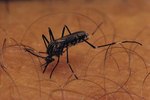If your horse's itchy ears are driving him crazy, get your vet out to examine him and make a diagnosis. There's a good chance that bugs are the culprit, so use fly repellent or a fly mask in the meantime, but avoid taking further steps without your vet's advice.
Ear Mites
If your horse's ears are drooping and head shaking accompanies his scratching, he may suffer from ear mite infestation. Your vet will perform skin scrapings to identify mites, or they may be apparent in any ear discharge. Other signs of mite infestation, which can develop into mange, include hair loss and thick, blood-tinged crustiness around the ears. Generally, regularly deworming your horse with ivermectin or moxidectin prevents mite infestation, and your vet may recommend dosing your horse with ivermectin and repeating the deworming two weeks later to eradicate active mites, or one dosing with moxidectin.
Fly Strike
If it's fly season and your horse's ears are itchy, fly strike is a real possibility. The tips of his ears contain crusty, weeping bumps and similar reddened, itchy areas may appear on the face, abdomen and his hind end. Before fly season starts, order ecofriendly fly predators to control stable flies. Pick up manure in the fields every day, and use fly spray, masks, fly sheets and wraps to protect your horse from biting flies.
Sweet Itch
If your horse is allergic to the bites of Culicoides midges -- often referred to as "no-see-ums" -- warm weather is the season of hell. That's because the saliva of these minute gnats causes intense itching in sensitive equines, a condition known as "sweet itch" or "summer itch." Your horse can't stop rubbing and scratching all affected areas, which usually include the ears, mane, tailhead, face and virtually anywhere else on the body. While manure removal and some of the same practices used for fly control help keep down the gnat population, additional treatments can help. These include:
- Adding organic apple cider vinegar to the feed
- Adding 2 tablespoons of garlic powder to the morning and evening meal
- Applying mentholated creams to vulnerable areas for gnat deterrence
- Putting baby oil on the mane, tail and ears -- gnats can't bite through it
- Rubbing scented dryer sheets onto the mane, tail, ears and face and over the rest of the body daily.
Ask your vet about other possible midge inhibitors, including:
- Avon Skin-So-Soft
- Gold Bond medicated powder
- Aveeno anti-itch products
Ear Infections
Equine ear infections are relatively uncommon, but affected horses can exhibit itchiness, along with neurological symptoms. These include:
- Circling
- Constant chewing motion
- Head tilt
- Partial facial paralysis
- Foul-smelling discharge
- Swelling
- Sensitivity to touch.
Your vet likely will prescribe topical and oral antibiotics to treat the infection locally and systemically.
Writer Bio
Jane Meggitt has been a writer for more than 20 years. In addition to reporting for a major newspaper chain, she has been published in "Horse News," "Suburban Classic," "Hoof Beats," "Equine Journal" and other publications. She has a Bachelor of Arts in English from New York University and an Associate of Arts from the American Academy of Dramatics Arts, New York City.




